PRE2020 3 Group7: Difference between revisions
| Line 267: | Line 267: | ||
[[File:clock_original.png| | [[File:clock_original.png|300px||left|thumb|Figure 1: Original clock design]] | ||
[[File:clock_adapted.png| | [[File:clock_adapted.png|300px||right|thumb|Figure 2: Adapted clock design]] | ||
For the adapted design we made all the background colors white, to give it a more professional appearance. Removed the second hand and moved the numbers outside the clock. The numbers have been moved outside the clock to make it easier to color in the pie slices on the clock without the numbers disappearing. | For the adapted design we made all the background colors white, to give it a more professional appearance. Removed the second hand and moved the numbers outside the clock. The numbers have been moved outside the clock to make it easier to color in the pie slices on the clock without the numbers disappearing. | ||
Revision as of 10:05, 8 March 2021
Time-Machine
When you are studying you sometimes forget an important meeting, because you are deeply focused on your materials. Also sometimes you need a little motivation to start studying. To solve that problem we are going to develop a clock that displays your agenda. So with one look at the clock you see exactly when you have appointments. Also the clock plans in your study time, when you are free of course and have sufficient time to study. It also gives you a push notification when you need to start studying in the form of a motivational message. This aid can be expanded in the future. With a light function that changes color and brightness according to your schedule. Also it could keep track of the usage of social media on your phone and when you use it too much it shuts it down. It could also be tracked with your webcam if you are truly studying and if not it sends you a notification(should be looked at with privacy regulations). And a lot more.
Group Members
| Name | Study | Student ID | |
|---|---|---|---|
| Wouter de Vries | Computer Science | 1463748 | w.p.h.d.vries@student.tue.nl |
| Ilana van den Akkerveken | Psychology & Technology | 1224158 | i.a.f.v.d.akkerveken@student.tue.nl |
| Joep Obers | Mechanical Engineering | 1455117 | j.g.p.m.obers@student.tue.nl |
| Jens Reijnen | Psychology & Technology | 1378074 | j.m.t.reijnen@student.tue.nl |
| Erick Hoogstrate | Mechanical Engineering | 1455176 | e.hoogstrate@student.tue.nl |
Planning
| Week | Activity | Name |
|---|---|---|
| 1 | Choose a subject | All |
| Literature research for the problem statement and SotA | All | |
| 2 | What should the robot look like | All |
| What should the robot be able to do | All | |
| 3 | Order Parts | Wouter |
| Make a survey | Jens & Ilana | |
| Make a first sketch of the idea | Joep | |
| 4 | Gather survey responses | All |
| Analyse survey responses | Jens & Ilana | |
| Put the raspberry together and install the basics | Wouter & Joep | |
| Look at how to plot a clock in python | Erick | |
| Look at how to extract an agenda in python | Joep | |
| 5 | Transfer data from agenda to clock | Erick & Joep & Wouter |
| Make small slices from the clock | Erick & Joep & Wouter | |
| Implement code on raspbery pi | Erick & Joep & Wouter | |
| Implement research from the survey | Jens & Ilana | |
| 6 | Complete the code to recieve agenda appointments in python | (All) |
| Complete the liturature on the wiki | All | |
| Start working on the interface | All | |
| 7 | x | x |
| x | x | |
| x | x | |
| x | x | |
| 8 | Finish the interface | All |
| Finish the program | All | |
| Do a user test | All | |
| x | x | |
| 9 | x | x |
| x | x | |
| x | x | |
| x | x |
Problem statement
We as students are confronted with Covid-19 for over a year, which caused drastic changes in our freedom for months. The consequences are noticeable in many areas but primarily in the psychological well-being of students. Since working and studying from home has become a norm, students report feelings of loneliness, less (study) motivation and less concentration. When all fun distractions cannot take place anymore and everyday seems a repetition of the day before, it is hard to stay productive. Therefore, it is important that we come up with a device that will keep students motivated to study and work from home. It has been said that sticking to a set schedule will help when working from home, but in practice this is not that easy. It could be beneficial for students to have some help with this. Help in making an executable and achievable week schedule with clear distinctions between work/study and relaxation. Additionally, the students should be made aware of their social media/ phone use in order to keep them focused and not distracted.
Approach
Approach
The approach to this project is as follows. Firstly, a literature study will be conducted to find multiple points that can influence or enhance concentration while studying. This might also help increase the understanding of which distractions are most common while studying. Secondly, a survey will be held. This survey is used to confirm the findings from the literature. Furthermore, if the data is gathered from actual students, it will contain practical problems that might not emerge from literature alone. In the meantime, the first bit of code and a very early prototype could be created. After all the data has been evaluated, the prototype can be finished (until further notice). A user-study/usability test will now be conducted to investigate how helpful the product truly is. As a finishing touch, the prototype or code may need to be adapted, dependent on the user tests.
Requirements
Students want to achieve their degree. In order to achieve it they need to study a lot, which can be very hard in the wrong environment. Therefore they require a stimulating study environment, but also after studying a place to relax and let go of all the stress.
Objectives
Objective
Milestones
This project and approach have multiple milestones. Firstly, the literature study. Secondly, the results of the survey can be considered a milestone. The third milestone would be a (functional) prototype. The final prototype, after the user-study has been conducted, is a big milestone. Finally, the completion of the wiki is the last milestone. From these milestones, we could conclude that the results of the survey and user-test, the prototype and the wiki are the deliverables of this project.
Deliverables
- survey-study
- prototype
- user-study
- complete wiki page
Users
For the users, we primarily based the project on students since they need to plan their own studies. While for people attending high school the schedule is mostly determined by the teachers. We also looked at people working at work so not from home, but that the clock would have the primary function of displaying the agenda. Changing colors and the other future options would be very distracting for other employees. The people working from home on the other hand could use this device since it could change the color and schedule working time the same way as study time for students. But the focus does not lie here and therefore they are the secondary users.
Primary Users
Students would be our primary users, therefore we did a survey study among 85 students in the age 17-27 years to gather information about the problems they face on a regular basis when studying from home. These students have different types of educational background. A multifunctional study clock could be beneficial for students who have trouble planning their day or have struggles with motivation and concentration.
Secondary Users
People working from home and people attending high school.
Survey study
An online survey is made using google forms. After some demographical questions, students are asked about their experiences and preferences concerning working/studying from home, using Likert-scale, to get a general idea about their needs. Afterwards they are asked about their opinion on our general idea, to see whether their needs and our expectations are in line. These questions will help us making choices for the design in order to fulfill the needs of the end users.
The full survey can be found here: https://forms.gle/vjDVp6oWTFR5Vjkt6
Results
This survey was distributed among friends and acquaintances of the researchers. In total there were 85 respondents, of which 56 male and 29 female, with an age between 17 and 27 years. In the responses on participant's experiences and preferences concerning working/studying from home we found some important problems. On the question 'When I'm studying, I get easily distracted' 52.9% of the respondents agreed and 27.1% even strongly agreed. Additionally, almost 65% struggles staying motivated while studying and more than half of the participants struggle to make and keep up with a clear planning. However, 76.4% answered they like to set goals for themselves while studying. These answers show that the majority of the respondents have problems with studying/working from home and could use some help for these problems. In the following pie-charts the responses on the project-related design questions are displayed.
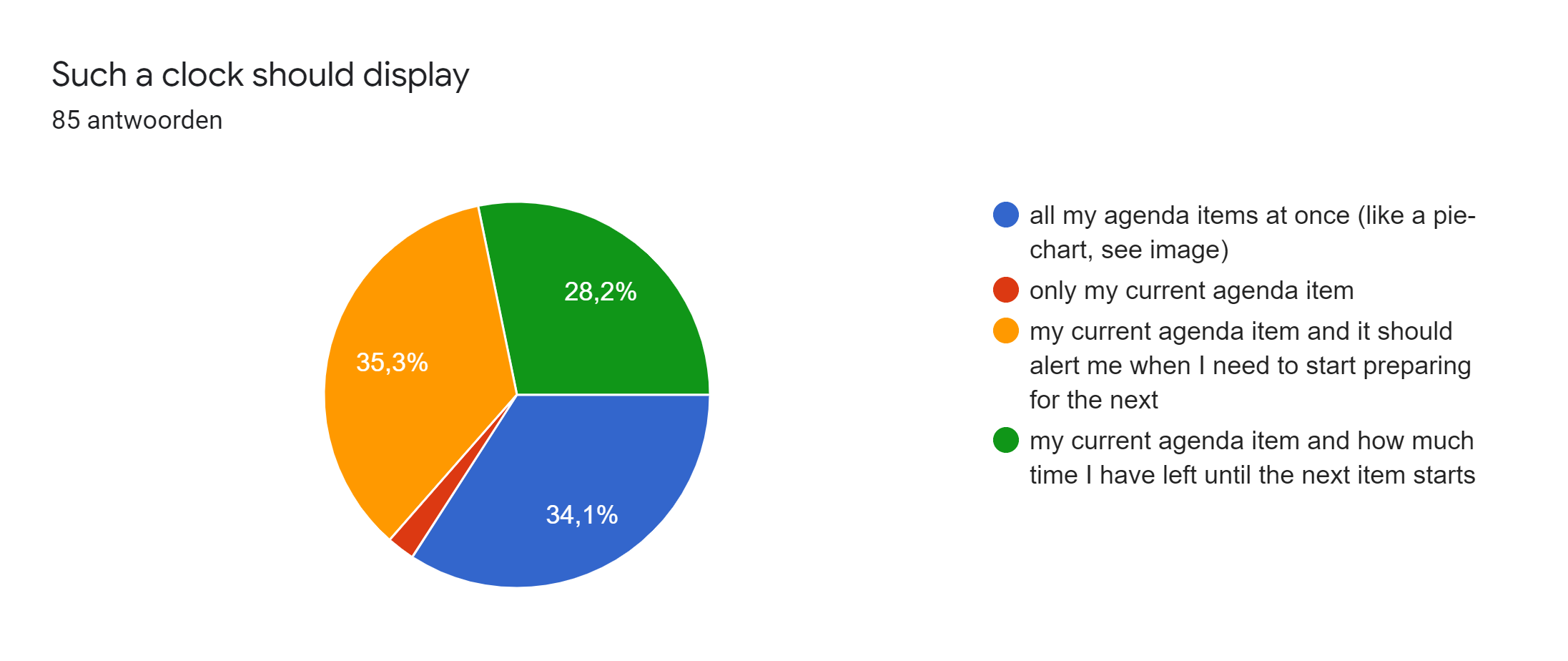
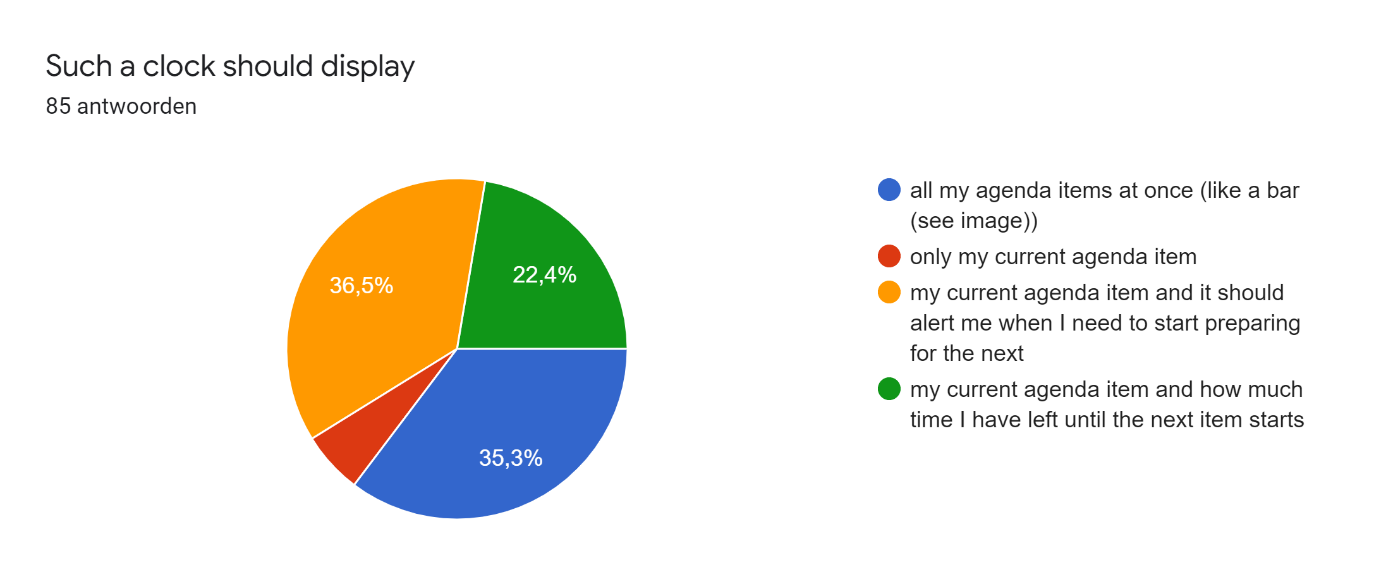

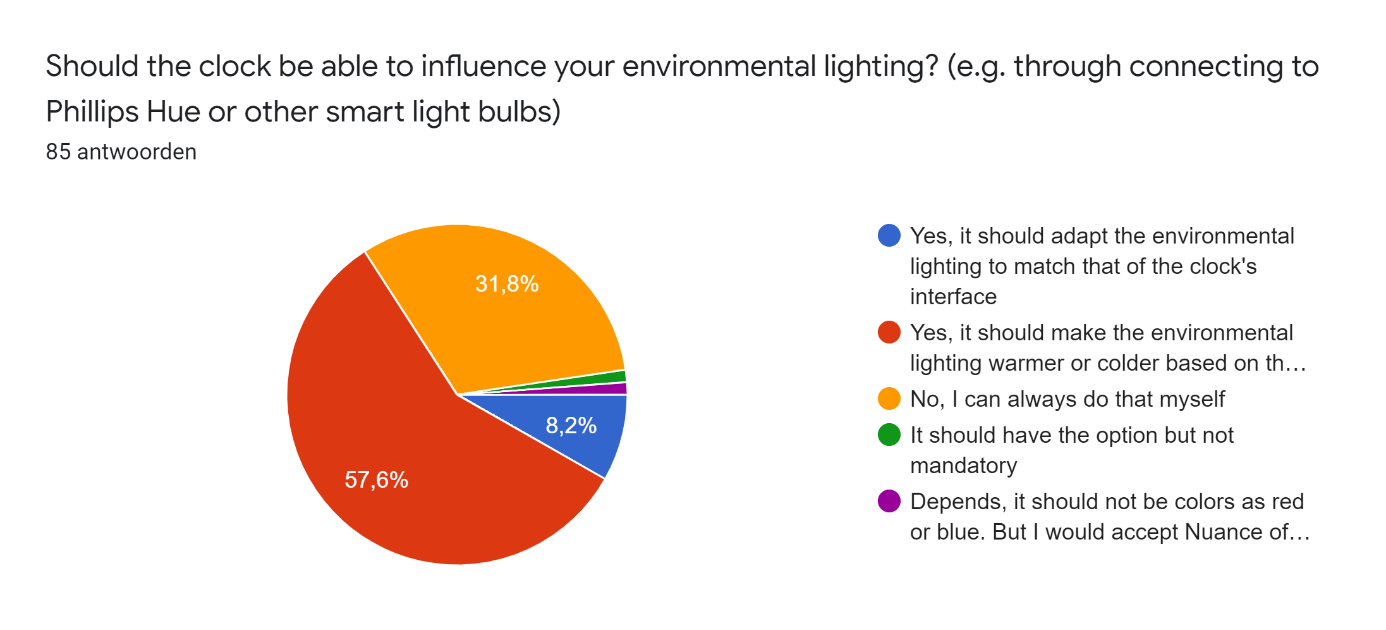

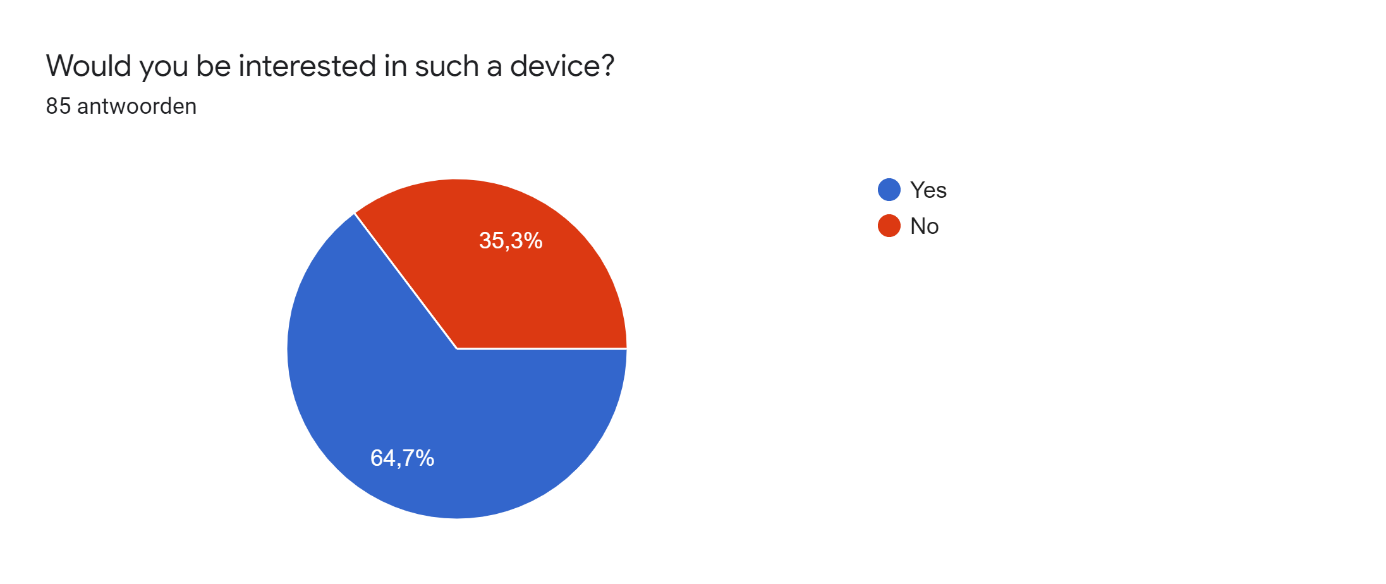
After answering the question on interest in the invention the people where asked to explain why or why not they would be willing to buy such a device in an open question. The answers to this will be added later on.
| Responses of people willing to buy a study-clock |
|---|
| - I think it could really help me study better and more active |
| - It could help me with my studying and concentration levels. |
| - Als het me helpt om te plannen en zorgt voor motivatie en structuur |
| - Because I am currently unable to keep track of everything that is due, a clock like this would help. However, it could also cause a lot of stress and should maybe have a setting where you can turn off the agenda setting. |
| - It might be motivating to know for how long i’m supposed to be studying, and help to prevent procrastinating |
| - I think it can help me to keep up with my schedule |
| - Because I'm looking for tools to improve my productivity. Id give it a try |
| - Because in my house it is almost always too dark and maybe such a device can help me to be more concentrated during studying |
| - I think it would be of great use |
| - It seems handy to just have an ‘agenda’ like that on the wall so you can see what you have to do at any time. An agenda inside a phone or physical agenda requires more time and effort, and doesnt help saying when you got to shift to a next part of your planning. A countdown timer seems like a great feature. |
| - Could help me stay focused an plan better |
| - It seems a cool idea and it might help me stick to a planning |
| - It might give some overview i am currently lacking. I also tend to forget what I wanted to do. |
| - It seems beneficial and inventive. |
| - Because it helps me with studying |
| - It would be usefull to have an item which can help you keep up with your agenda without having to grab you phone and seeing all sorts of distractions |
| - Nice thing to have if cheap |
| - Helps me stay motivated |
| - It takes out some stress, I think, because it could alarm me when I should prepare for something I forgot |
| - To keep track of my plans for the day and to help me motivate myself to continue working |
| - Because it helps with your daily things |
| - It seems useful enough in a time where almost everyone struggles to find much motivation or structure in their life |
| - Simply for convenience, and short time interval planning enforces concentration since you'll feel like there is no time for procrastination. |
| - To help me manage my time |
| - It helps me motivate to study and reduces stress when it is a planning |
| - Could give me a clear view of what I should be doing at that time without always checking my agenda and helps stay focussed more easily. |
| - Improve planning |
| - Cause I struggle with planning and motivation, it is hard to keep in your study rhythm. |
| - Could be pretty handy |
| - It would help me to keep a nice overview of my tasks without being overwhelming and help me to remain focused on my tasks |
| - Maybe it would motivate me to keep up with my planning |
| - Its a clock and agenda in one device, and regulates your meetings/planning |
| - It seems like an easy way to keep a clear overview of your day, without having to constantly grab your agenda. I also think this device could help me with a planning if it tells my how much study time I have left |
| - Handy way to see calendar |
| - I like the idea and since the influences of light on concentration and vitality are promising it seems like a useful tool. |
| - I really struggle with the studying in current conditions and would welcome the opportunity of improvement. |
| - Since I am a student that needs a useful and handy way to look at my agenda without having to pull it up on my phone or computer. |
| - It can help me schedule my tasks |
| - Because I have some struggle with time management, sometimes |
| - It reminds the agenda better than a human brain |
| - It allows me to get an overview of my daily task in one glance |
| - It might help in terms of organizing and staying on track with your schedule |
| - As it is Innovative |
| - I want to try everything that possible helps my study |
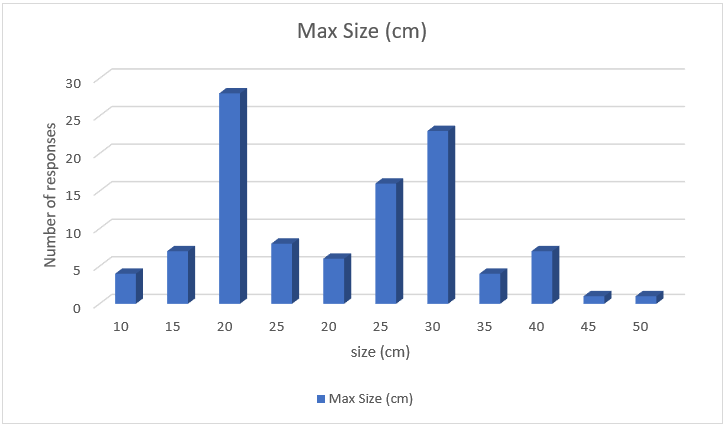

Prototype
First sketch
For a first design idea, we came u[p with a 7-inch display that can be fitted on top of your desk. What the specifications are for this particular design will be determined in a later stadium. But for now, we want you to know how the design will look like.
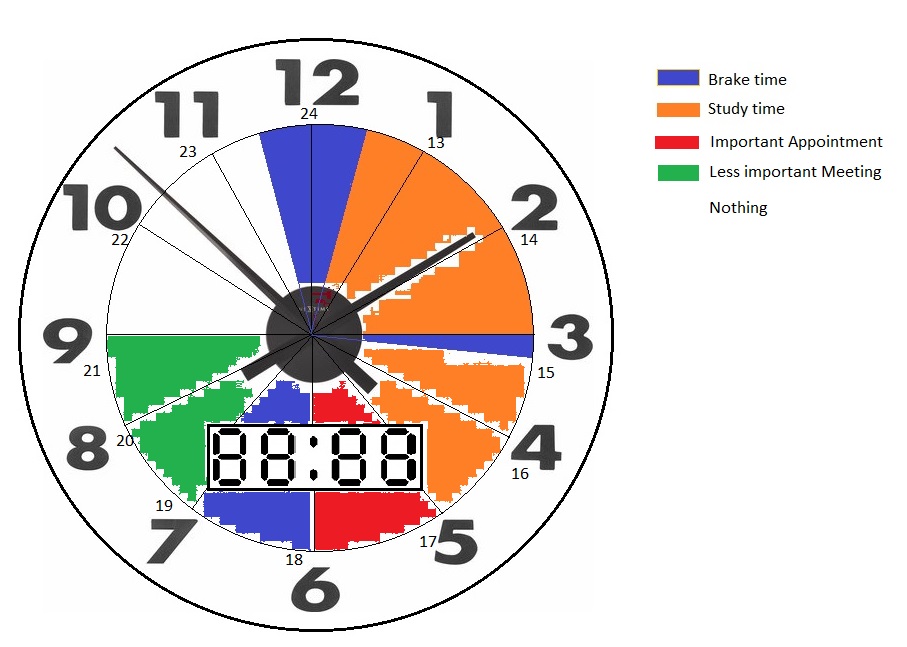
In this figure, you see the first design we had in mind. When you have sufficient free time at a specific moment the clock will schedule study time for you. It will also display your appointments see you have a quick overview of your day. When the clock passes the hour it will automatically update to 12 hours later, for instance from 01:00 to 13:00. This could be altered in the future and depends on what the user prefers. It also should the digital time on the screen for the user that finds this more convenient. This function can be switched on or of in the settings.
First Interface
For the first prototype, we looked at different designs for clocks. Eventually, we landed upon the design which can be seen in Figure 1. This design has numbers that indicate the time and has clear clock hands.
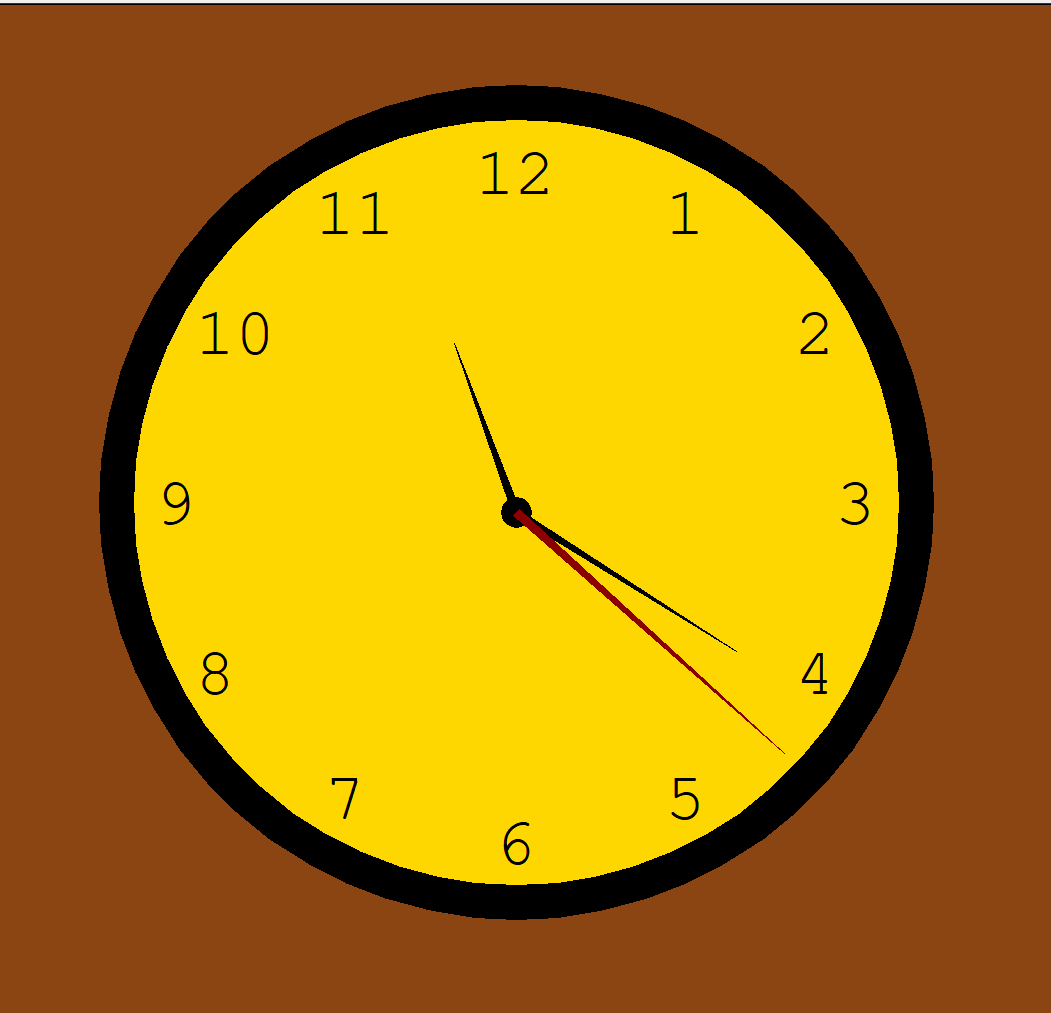

For the adapted design we made all the background colors white, to give it a more professional appearance. Removed the second hand and moved the numbers outside the clock. The numbers have been moved outside the clock to make it easier to color in the pie slices on the clock without the numbers disappearing.
However, there have been some problems with getting it to work on the raspberry pi. At this moment it is unclear what the problem exactly is.
Status of the prototype
When we received the parts we needed for this project, which are a raspberry pi 3B+ and a 7 inch touch screen for the raspberry. First we put the different parts together, then installed Raspbian on the pi so we could use it. The pi was running in no time and the screen worked perfectly. We thought that the touchscreen would require special drivers or programs but this was not the case. Now the base setup was done.
After this we setup a remote connection with the use of VNC Viewer. This is done so every team member an work on the pi from home without having the pi at home. When the remote connection was set up. A virtual keyboard should installed. This is needed for later use if you want to type anything using the touch screen.
The only problem now is that the screen does not stand on itself therefore brackets where made so the screen can actually stand on your desk. The angle on which it stands is not definite and could be changed in the future, since the most convenient angle should be determined.
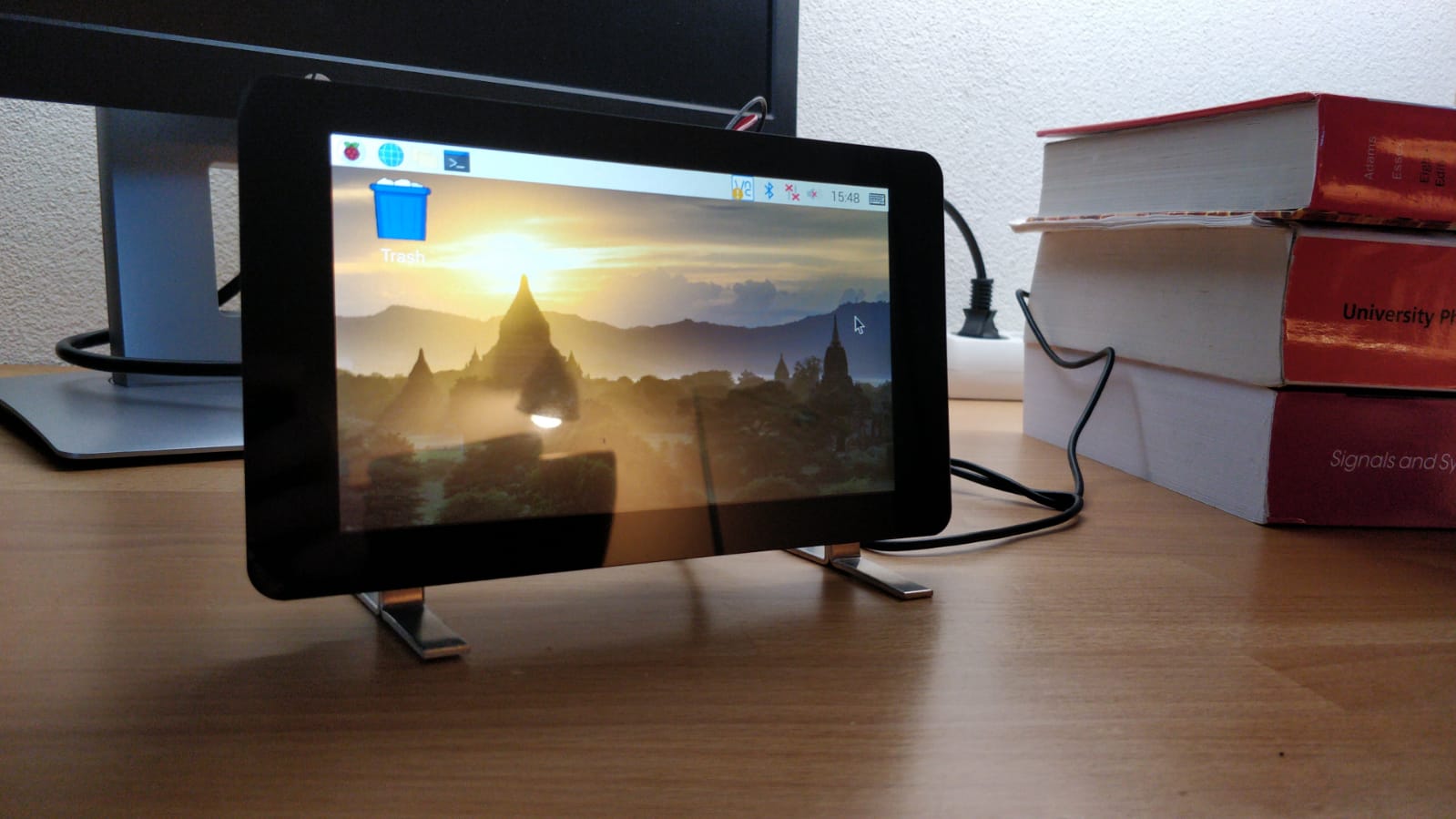
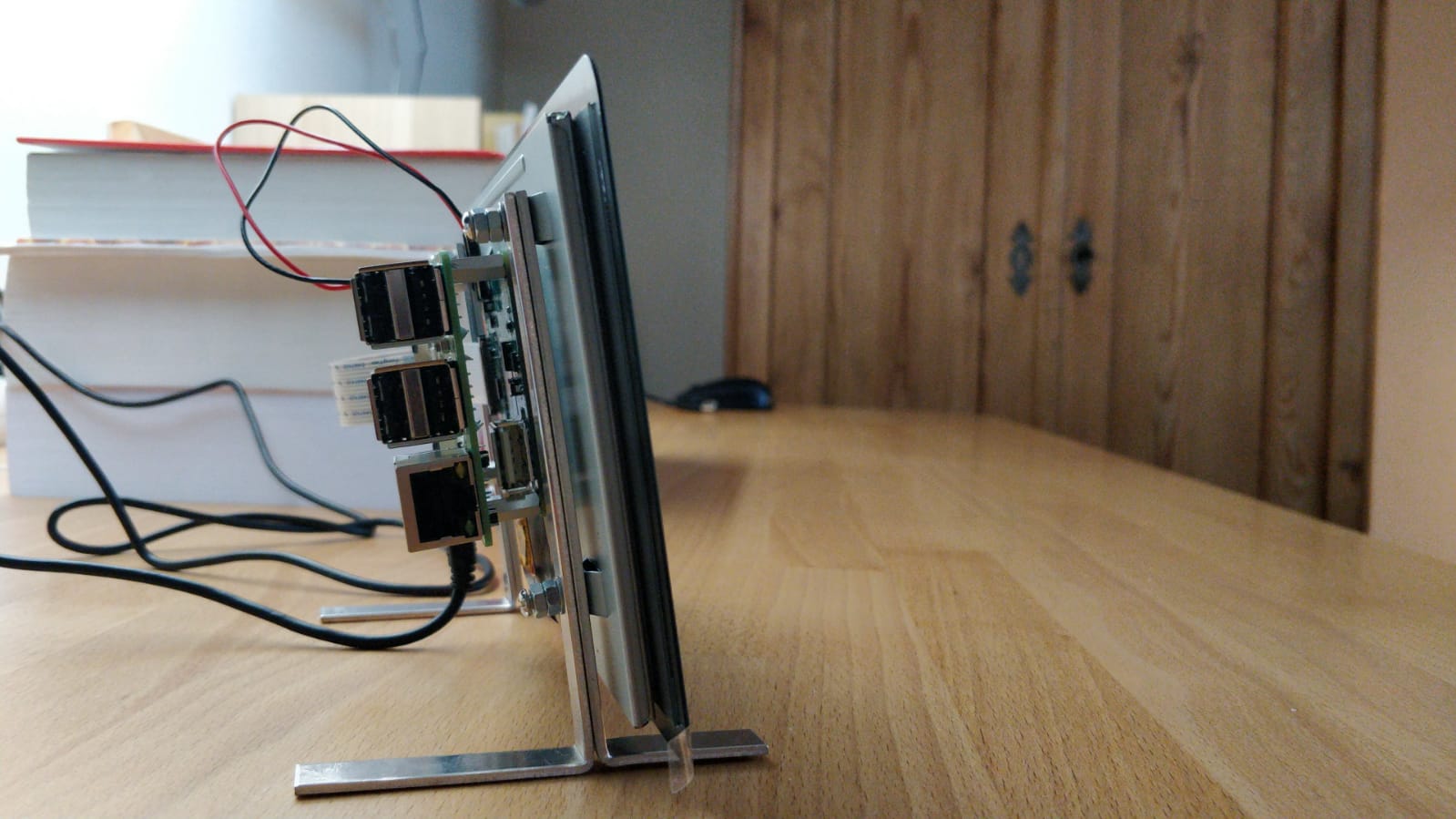
State of the Art
1. Bahsi, I., Çetkin, M., Orhan, M., Kervancioglu, P., Sayin, S., & Ayan, H. (2017). Evaluation of Attention - motivation level, studying environment and methods of medical faculty students. European Journal of Therapeutics, 1-7.
- This article reports a survey study that was held at the medical faculty of the Gaziantep University school of Medics. The survey considered 11 open-ended demographical questions and 29 Likert-scaled questions about the study environment, attention spans and motivation levels during study and study methods. The researchers used this data to find out how to increase the Grade Point Average (GPA). They concluded that is good to inform students about factors that can influence attention spans and motivation, identifying good learning strategies is beneficial for students and a good place to study is essential.
2. Bunce, D. M., Flens, E. A., & Neiles, K. Y. (2010). How Long Can Students Pay Attention in Class? A Study of Student Attention Decline Using Clickers. Journal of Chemical Education, 1438-1443.
- In this study, the researchers investigated how much attention students of chemistry classes could maintain during their lectures. They noted at the start that there were two types of interactivity in a lecture. The first type were quizzes that involved the use of a clicker. This allowed students to answer multiple choice questions on the smartboard and the teacher could show how the students did on these questions immediately. A second way was by doing demonstrations of the phenomena they explained. The study, however, only focused on the first part.
This study asked students to report lapses of attention through their clickers. Before this study, the researchers expected that students would be able to stay focused for 10 – 20 minutes at a time, disregarding the first and last 5 minutes of lecture, where no student would be active. However, they found that students continuously alternate between being engaged or disengaged during a lecture for periods as short as 1-2 minutes. The suspicion that students are more engaged during interactive parts of the lecture was still confirmed. The researchers advise teachers to use interactive ways of teaching and include multiple student-centered pedagogies in their lessons.
3. Saalmann, Y. B., Pigarev, I. N., & Vidyasagar, T. R. (2007). Neural Mechanisms of Visual Attention: How Top-Down Feedback Highlights Relevant Locations. Science, 1612-1615.
- In this article, attention is defined as a mechanism that is used to select relevant information from the environment. The authors state that this is a top-down process. There is evidence that the posterior parietal cortex (PPC) is a brain area that is heavily involved in attention. This area is part of a dorsal stream and thus mainly considers spatial information. These two statements are backed by studies with monkeys. In an experiment where monkeys had to respond to certain stimuli, the response times of the monkeys who had to respond to ‘spatial’ or ‘spatial and featural’ stimuli responded significantly faster compared to monkeys in a ‘neutral’ condition. These experiments tested the response of the medial temporal (MT response) lobes, but found that the MT response got feedback from the lateral intraparietal area (LIP). This was evidence for the top-down feedback.
From these experiments, they concluded that attention is gained quicker if stimuli were within the visual field and if a preceding stimulus was presented within the visual field as well.
4. Buckley, P., & Doyle, E. (2014). Gamification and student motivation. Interactive Learning Environments, 24(6), 1162–1175. https://doi.org/10.1080/10494820.2014.964263
- The gamification of the learning process shows to have a positive effect on the learning experience. While playing people will be more engaged with the material and be more productive. This helps the student to be more motivated to study. However, this effect is mainly visible in students that are naturally keen on learning / are willing to learn. Students who do not like to learn will have different results. However, the method looks promising.
5. Seifert, T. (2004). Understanding student motivation. Educational Research, 46(2), 137–149. https://doi.org/10.1080/0013188042000222421
- A student's motivation can be based on multiple variables, for instance: religion, parents, self-efficacy, self-worth and willingness to achieve certain goals among other things. A student’s motivation will have an influence on the way he or she will learn. It will have an effect on the behavior of things like the pursuit of mastery, failure avoidance, learned helplessness, and passive aggression. Students prefer their work to be meaningful and they like to have control and autonomy during their study. However in the end it all comes down to the personal emotions and beliefs of each student to really get a feel for their individual motivation.
6. Ames, C. (1992). Classrooms: Goals, structures, and student motivation. Journal of Educational Psychology, 84(3), 261–271. https://doi.org/10.1037/0022-0663.84.3.261
- This article shows the importance of a good working environment and what kind of effects this can have on the learning behavior and motivation of the students.
7. Zheng, S., Han, K., Rosson, M. B., & Carroll, J. M. (2016). The Role of Social Media in MOOCs. Proceedings of the Third (2016) ACM Conference on Learning @ Scale, Association for Computing Machinery. https://doi.org/10.1145/2876034.2876047
- Summary
8. Iriarte, Y., Diaz-Orueta, U., Cueto, E., Irazustabarrena, P., Banterla, F., & Climent, G. (2012). AULA—Advanced Virtual Reality Tool for the Assessment of Attention. Journal of Attention Disorders, 20(6), 542–568. https://doi.org/10.1177/1087054712465335
- This paper shows the benefit of using a VR “game” to perform tests on students with a disorder, like ADHD. Since it helps them to focus better on the different tasks than if they would have done them with paper and pencil. While the test in the paper is focused on a younger audience, 6 to 16 years, it could give an indication for (young) adults as well. There also seems to be a difference in performance when looking at the different genders. The main takeaway message is that VR can be used to help students with a (learning) disorder to focus better by removing distractors for instance.
9. van Gog, T., & Scheiter, K. (2010). Eye tracking as a tool to study and enhance multimedia learning. Learning and Instruction, 20(2), 95–99. https://doi.org/10.1016/j.learninstruc.2009.02.009
- Eye tracking can be used as an input but also to measure the effect of various learning processes which make use of visual attention cues. Eye-tracking can provide more information on the split-attention effect, modality effect, redundancy effect, goal-specificity effect. The information gathered can be used to optimize learning strategies or layouts.
10. Vandewalle, G., Maquet, P., & Dijk, D. (2009). Light as a modulator of cognitive brain function. Trends in Cognitive Sciences, 13(10), 429-438. doi:https://doi.org/10.1016/j.tics.2009.07.004
- According to this article wavelength, duration, and intensity of light exposure modulates brain responses. Immediately after light exposure, you can observe physiology, for example, heart rate, sleep propensity, alertness, and body temperature. The non-visual responses are maximally for blue light (480nm) while the spectral sensitivity of classical photoreceptors is maximal for green light (550nm).
- Also, cognition is affected by light in which we are interested the most. Because this includes attention, executive functions, and memory. These cognitive performances decline during the biological night and progressively improve during the biological day. The light could affect cognitive performance through its synchronizing/phase-shifting effects on the circadian clock. Also with light exposure, cognitive performance can be increased acutely.
- From the article, we can conclude that exposure to blue light gives the highest brain-responses ranging from a few seconds to about 20 minutes.
11. Selvaraj, S. (2013, October). (Pdf) impact of social media on student's academic performance. Retrieved February 06, 2021, from https://www.researchgate.net/publication/288516435_IMPACT_OF_SOCIAL_MEDIA_ON_STUDENT%27S_ACADEMIC_PERFORMANCE
- According to this article students are very fond of using social media such as Facebook, Twitter, YouTube (based on the social media form 2013). The colleges are now pushing the classroom through social networks. Also, most of the information on social networks is fake or half-truth which could be a problem for students. Also, the students become addicted to social networks, which also means that their real-life friends become less in numbers while the digital friends become more and more. Too much of anything is good for nothing.
12. Perrin, A. (2020, May 30). Social media usage: 2005-2015. Retrieved February 06, 2021, from https://www.pewresearch.org/internet/2015/10/08/social-networking-usage-2005-2015/
- From this article, we can conclude that social media usage has increased very much between 2005 and 2015. From which we can only imagine that the trend continued to 2021. So the usage of social media is enormous. Young adults between 18 and 29 years are most likely to use social media 90% of this group uses social media.
13. Küller, R. (2002). The influence of light on circarhythms in humans. Journal of PHYSIOLOGICAL ANTHROPOLOGY and Applied Human Science, 21(2), 87-91. doi:10.2114/jpa.21.87
- Humans have a circadian rhythm from approximately 24 hours, including being awake and asleep. This process is regulated by neural and hormonal processes. This process is being synchronized by the solar night and day. When far from the equator this internal clock can be disrupted by the short days and long nights (for half a year) which results in fatigue, sadness, and sleep problems. When you are indoors for a long time indoors during the day, windows are very important. Dark environments can have a negative effect on well-being and work capacity.
- All types of light within the visual range can have an influence on the biological clock. Bright is more effective than dim light and white or daylight more effective than colored light(possible with some exceptions).
14. Ogbodo, R. (2010). Effective study habits in educational sector: Counselling implications. Edo Journal of Counselling, 3(2), 229-239. doi:10.4314/ejc.v3i2.63610
- In this paper, good study habits are discussed. The most important conclusion from this paper is that to form effective study habits you should have good counseling. They help you with a proper study schedule. They also note that a study should be divided into three periods where the subjects should be divided into relative importance. Also, a good schedule is very important in maintaining a good study schedule. And one point they note is: Do you have enough light in your study place?
15. Ezemenaka, E. (2013). The usage and impact of Internet enabled phones on academic concentration among students of tertiary institutions: A study at the University of Ibadan, Nigeria. International Journal of Education and Development using Information and Communication Technology (IJEDICT), 162-173.
- The author states that students have been more and more distracted since the introduction of the smartphone and that academic performance has become lower. They state, however, that there is no evidence linking the one to the other yet. The goal of their research is to find this link, if it exists. A survey-study was used to find out how many students used smartphones, what they used them for and whether they thought that it had an influence on their academic performance. The outcome of this study was that there was no significant relation detected between the use of a smartphone and academic performance.
16. Raviv, S., & Low, M. (1990). Influence of Physical Activity on Concentration among Junior High-School Students. Perceptual and Motor Skills, 67-74.
- It has been speculated a lot of times that students’ concentration decreases by a lot after physical exercise. They should be highly aroused, which leads a decrease in their concentration. This study found three things. Firstly, there does not seem to be a difference in concentration between physical or science classes. Secondly, concentration levels are very low at the beginning of a (science) class and higher near the end, but not so much to say that there is a significant effect. Thirdly, the concentration levels of all students are generally higher in the morning than they are in the afternoon. This means that the study found that concentration levels depend more on time than on the nature of the class.
References
Reference 1
Logbook
| Date | Name | Activity | Time spent (HH:MM) |
|---|---|---|---|
| 01/02/21 | All | Whatsapp Discussion | 1:00 |
| 01/02/21 | All | Group Meeting | 1:30 |
| 01/02/21 | Jens | Approach, milestones and deliverables | 0:15 |
| 01/02/21 | Joep | Literature study for SotA | 2:30 |
| 03/02/21 | Jens | Literature study for SotA | 3:30 |
| 03/02/21 | Erick | Literature study for SotA | 2:30 |
| 03/02/21 | Ilana | Literature study for SotA | 2:00 |
| 03/02/21 | Wouter | Programming research | 2:00 |
| 04/02/21 | Erick | Updating wiki page | 0:30 |
| 04/02/21 | All | Group Meeting | 1:30 |
| 04/02/21 | Erick | Updating wiki page | 0:35 |
| 04/02/21 | Ilana | Problem statement | 0:45 |
| 04/02/21 | Ilana | Literature study for SotA | 2:00 |
| 04/02/21 | Joep | Literature study for SotA | 1:00 |
| 05/02/21 | Jens | Literature study for SotA | 1:30 |
| 05/02/21 | Joep | Literature study for SotA | 2:00 |
| 06/02/21 | Erick | Literature study for SotA | 2:00 |
| 06/02/21 | Ilana | Literature study for SotA | 2:00 |
| 06/02/21 | Joep | Literature study for SotA | 2:00 |
| 08/02/21 | Erick | Coming up with ideas | 0:30 |
| 17/02/21 | Erick | List of materials | 2:00 |
| 20/02/21 | Joep | Description | 1:00 |
| 24/02/21 | Erick,Joep,Wouter | Meeting for list of materials | 1:00 |
| 24/02/21 | Jens, Ilana | creating online survey | 2:30 |
| 25/02/21 | All | Group Meeting | 1:00 |
| 25/02/21 | Joep | Sketching | 1:00 |
| 01/03/21 | All | Group Meeting | 1:00 |
| 01/02/21 | Joep | udating the wiki and write first sketch | 1:30 |
| 26/02/21 | Jens, Ilana | Finishing the survey | 1:00 |
| 01/03/20 - 04/03/21 | Jens | Quickly overlooking survey results and responses | 0:30 |
| 04/03/21 | Jens, Ilana | Converting and analysing survey data | 2:00 |
| 04/03/21 | Wouter,Joep | Setting up the raspberry pi | 4:00 |
| 04/03/21 | All | Group meeting | 0:45 |
| 04/03/21 | Joep | Updating the wiki | 1:00 |
| 05/03/21 | Jens, Ilana | Analyse survey and create graphs. Update wiki. | 2:00 |
| 05/03/21 | Joep | Setting up the virtual keyboard | 1:30 |
| 05/03/21 | Erick | Research into plotting different clocks with python | 1:30 |
| 06/03/21 | Erick | Adapting the clock and implementation | 1:00 |
| 06/03/21 | Joep | Making a holder for the screen of the rpi | 1:00 |
| 07/03/21 | Ilana | Updating the wiki | 1:00 |
| 07/03/21 | Joep | Writing Status of prototype and updating the planning | 1:00 |